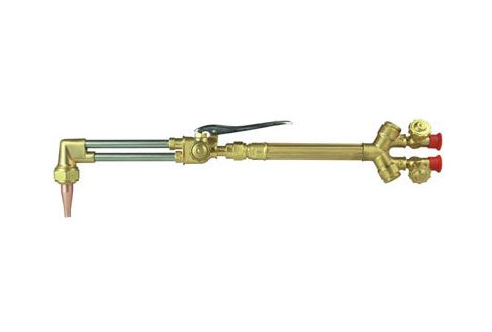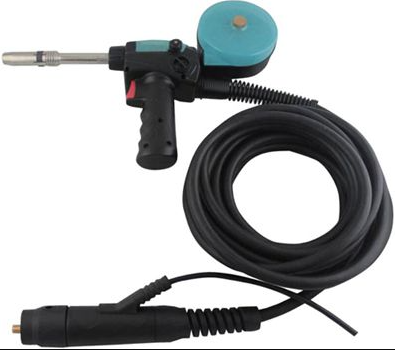To maximize the benefits of MIG welding, the right MIG welding torch must be selected for the job. The specification of this equipment can significantly affect productivity, downtime, weld quality, and operating costs - as well as the comfort of the welding operator.
MIG welding is considered to be one of the easiest welding processes to learn and is suitable for a wide range of applications and industries. As the wire is continuously passed through the MIG welding torch during the process, there is no need to stop as often as with stick welding. The result is faster travel speeds and higher productivity.
The versatility and speed of MIG welding also make it ideal for all-position welding of a wide range of metals in various thicknesses, including mild and stainless steel. In addition, it produces cleaner welds that require less cleaning than the stick or flux-cored welding.
However, in order to maximize the benefits offered by this process, the right MIG gun must be selected for the job. In fact, the specification of this equipment can significantly affect productivity, downtime, weld quality, and operating costs - as well as the comfort of the welding operator. Here are the different types of MIG guns and some of the key factors to consider when choosing one.

Welding Torch
Water-cooled vs air-cooled MIG gun
Air-cooled: Air-cooled guns use ambient air and shielding gas to dissipate excess heat. The power cable on an air-cooled gun contains more copper than the cable on a water-cooled gun to help prevent the cable insulation from melting or burning. As a result, in most cases, air-cooled guns are heavier and less flexible than water-cooled guns. However, air-cooled systems are less expensive because they do not require a separate radiator cooling system and the additional hoses associated with water-cooled systems. The simpler design of the air-cooled unit makes it easier to operate, assemble, maintain and support. Air-cooled MIG guns typically have a wide range of currents between 150 and 600 amps.
Water Cooled: Water-cooled MIG gun systems require a radiator cooling system to circulate water, ambient air, and protective gas to dissipate the heat from the gun. However, water-cooled gun cables are lighter and more flexible as they contain less copper than air-cooled systems. Water-cooled MIG guns are typically available in the 300 to the 600-amp range.
Heavy duty vs. light duty MIG guns
While a lower amperage torch may be suitable for some applications, make sure it provides the necessary welding capacity for the job. Lightweight MIG guns are often the best choice for applications that require short arcing times, such as positioning parts or welding sheet metal. Lightweight guns typically offer capacities of 100 to 300 amps, and they tend to be smaller and lighter than heavy-duty guns. Most lightweight MIG guns also have small, compact handles for greater comfort for the welding operator.
Lightweight MIG guns offer standard features at a lower price. They use light or standard consumables (nozzles, contact tips, and fixing tips) which are smaller in mass and less expensive than heavy-duty consumables.
The strain relief on light-duty guns usually consists of flexible rubber parts, which in some cases may not be present. Therefore, care should be taken to prevent kinking which may affect wire feed and airflow. Please also note that overworking a light-duty MIG gun may lead to premature failure and therefore this type of gun may not be suitable for facilities with multiple applications and various amperage requirements.

Spool Torch
Heavy duty MIG guns, on the other hand, are the best choice for jobs that require long arc times or multiple passes over thick sections of material, including many applications in heavy equipment fabrication and other demanding welding operations. These guns typically have a current range of 400 to 600 amps and are available in air and water-cooled models. They often have larger handles to accommodate the larger cables required to deliver these higher currents. These guns often use heavy-duty front-end consumables capable of withstanding high currents and longer arcing times. The neck is also usually longer to allow more distance between the welding operator and the high heat output of the arc.
Fume extraction guns
For certain applications and welding operations, a fume extraction gun may be the best option. Industry standards from the Occupational Safety and Health Administration (OSHA) and other safety regulators set permissible exposure limits for welding fumes and other particulates, including hexavalent chromium, which has led to investment by many companies. Similarly, companies seeking to optimize welding operator safety and attract new skilled welding operators to their sites may want to consider using these guns as they can help create a more attractive working environment. Fume extraction guns are typically available in amperage levels between 300 and 600 amps, as well as a variety of cable styles and handle designs. As with all welding equipment, they have their benefits and limitations, optimum applications, maintenance requirements, and more.

MIG Torch
Image of a clean air fume extraction MIG gun
A distinct advantage of fume extraction guns is that they remove fumes at the source, minimizing the number of fumes entering the welding operator's direct breathing zone.
Combined with many other variables in the welding operation (wire selection, specific transfer methods, welding processes, welding operator behavior, and substrate selection), fume extraction guns can help companies comply with safety regulations and create a cleaner, more comfortable welding environment.
These guns operate by capturing the fumes generated by the welding process at the source, above and around the weld pool. Various manufacturers have proprietary methods of manufacturing guns to perform this operation, but at a basic level, they all operate similarly: by mass flow or material movement. This movement occurs through a vacuum chamber which draws the fumes through the gun handle and into the gun hose and then through a port on the filter system (sometimes informally referred to as a vacuum chamber).
Fume extraction guns are ideally suited to applications using solid wire, flux cored wire, or metal cored wire as well as applications that take place in confined spaces. These include, but are not limited to, applications in the shipbuilding and heavy equipment manufacturing industries as well as the general fabrication and manufacturing industry. They are also ideal for welding mild and carbon steel applications as well as stainless steel applications, as this material produces higher levels of hexavalent chromium. In addition, these guns work well in high current and high deposition rate applications.








